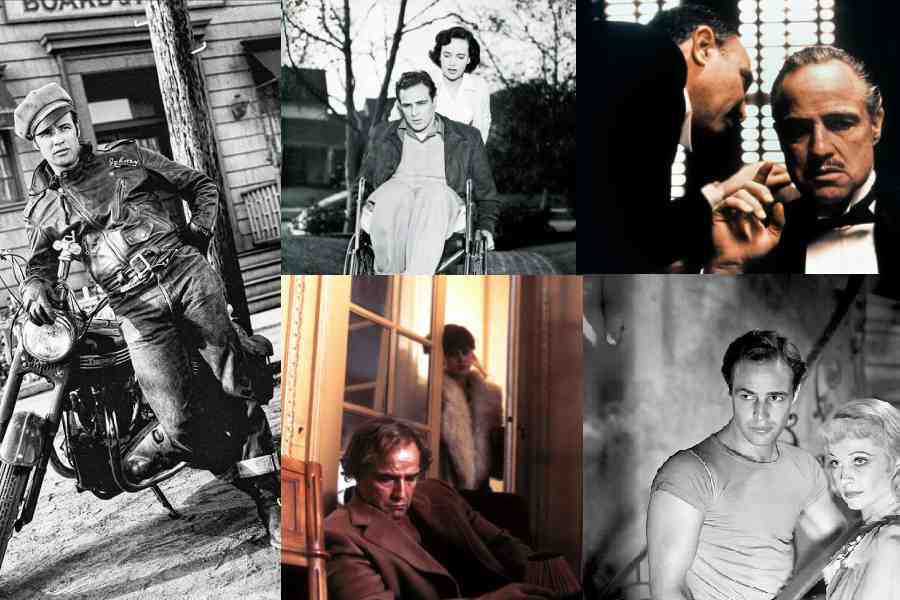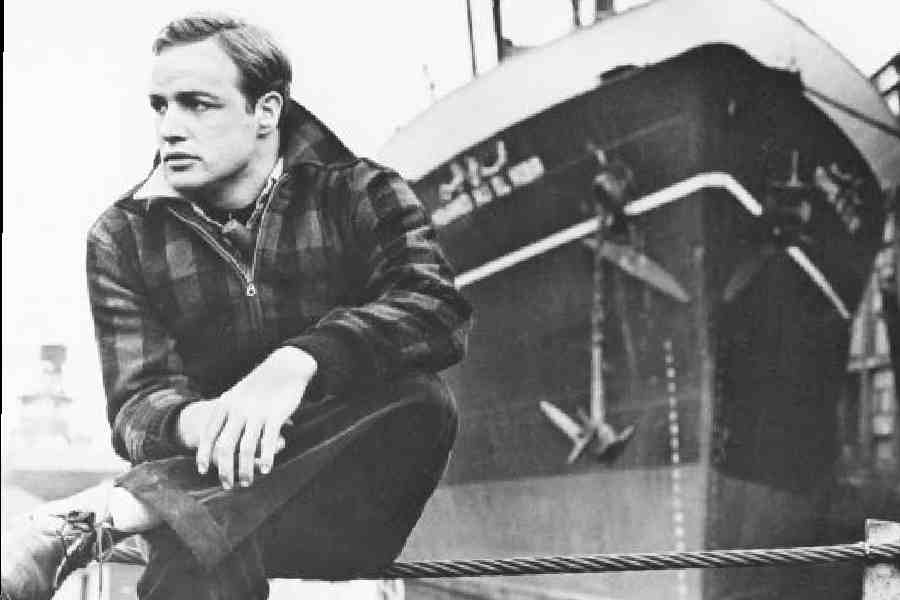On The Waterfront
Marlon Brando’s collaboration with maverick filmmaker Elia Kazan yielded what is widely regarded as the actor’s greatest performance. As the inarticulate, instinctively alienated bum, Terry Malloy — a former boxer who retires after losing a fixed fight and goes on to join the workers’ union — Brando delivered an act that, in many ways, redefined the scope and definition of acting in the film medium. His character reflected Kazan’s own ideals, a metaphor for fighting injustice, with the film distinguishing itself as the description of a maligned system and not just a story about good guys and bad.
Brando’s idiom of method acting — till then an alien concept for most in cinema and beyond — was evident in On The Waterfront that won him his first Best Actor Oscar. Terry appears to be a boorish, gum-chewing, uneducated man on the surface but Brando’s performance is tempered with a practised nuance and sensitivity that only he could have brought in. Even today, Terry saying: “You don’t understand! I could’ve had class. I could’ve been a contender. I could’ve been somebody instead of a bum, which is what I am,” occupies a permanent spot in cinema show reels.
A Streetcar Named Desire
Yet another collaboration between Kazan and Brando, one which can be counted as one of the finest for both. A Streetcar Named Desire, adapted from Tennessee Williams’s Pulitzer Prize-winning play of the same name, is distinguished by a giant of a performance from Brando as a primeval brute, contrasted well with that of Vivian Leigh’s, which evoked pity and terror.
A film seething with atmosphere, A Streetcar Named Desire was a step forward in the evolution of American cinema, bringing audiences startling, raw emotion that they had seldom seen on the big screen before.
Brando was a standout as Stanley Kowalski, internalising deep human feeling and conveying that through subtle acting and emotional cues. In short, he was electric, moving with animal magnetism and charisma and a power that was indescribable. You couldn’t take your eyes off of him every time he was on screen.
The Godfather
What can be said about Marlon Brando in The Godfather that hasn’t been said before? Embodying Vito Corleone — one of the greatest characters in the history of cinema — Brando was magnetic and mesmerising in Francis Ford Coppola’s seminal multi-generational gangster drama which is often considered the greatest film ever made.
Brando completely disappeared into his role of the mafioso patriarch, changing everything from appearance to accent. He even stuffed cotton balls in his cheeks to alter his face and voice. For the audition, he smeared black shoe polish on his blond hair and slicked it back. His mumbling weak voice came from the fact that Vito had been shot in the throat in his younger days.
That The Godfather not only became a blockbuster but also a cultural phenomenon was in a large part because of how Brando wholeheartedly threw himself into the character, going as far as slapping a co-star during a scene without the latter being none the wiser about it.
“He made acting natural, honest, personal,” writes William J. Mann in the 2019 biography The Contender: The Story of Marlon Brando. His turn as Vito Corleone embodied that. Brando was the most celebrated of the method actors, and his slurred, mumbling delivery, especially in The Godfather, depicted his rejection of classical dramatic training.
Last Tango in Paris
Portraying a recently widowed American man who begins an anonymous sexual relationship with a young Parisian woman, Brando was his usual brilliant self in this controversial Bernardo Bertolucci film that had graphic depictions of sex and sexual violence. The film was driven almost singlehandedly by a blazing Brando, who at the height of his fame and talent, delivered a raw, emotionally naked performance which helped dispel some of the film’s weak writing and sensationalist feel. His monologues in the film still have the power to devastate.
The New Yorker summed it up perfectly with: “When Brando improvises within Bertolucci’s structure, his full art is realised; his performance is intuitive, rapt, princely. Working with Brando, Bertolucci achieves realism with the terror of actual experience still alive on the screen.”
The Men
Brando’s debut film, released in 1950, had him in the role of a paralysed war veteran who has to spend the rest of his life on a wheelchair. To prep for the part, Brando — who was hailed as “an important new star in the Hollywood horizon” on debut — spent a month in the paraplegic ward of a hospital.
A recruit from the New York stage, Brando was persuasive in his Hollywood debut, a film which remains memorable for depicting the human cost of war. In just his first film, Brando showcased his ability to transcend even average material.

The Wild One
This 1953 film, one of the earliest in Brando’s career, is known for the character of Johnny Strabler, with Brando’s charm and charisma, talent and screen presence turning it into a cultural icon of the 1950s.
The Wild One is considered to be the ‘original outlaw biker film’ and perhaps the first to explore American outlaw motorcycle gang violence. Sporting long sideburns, a Perfecto-style motorcycle jacket, a tilted cap and riding a 1950 Triumph Thunderbird 6T, a handsome Brando became an influential image as the rebel with a cause who heralded the arrival of the Beat Generation. The film may seem a tad dated 70 years later, but Brando’s powerful performance — “Whaddya got?” — is for the ages.
Julius Caesar
Widely considered to be the best movie version of the William Shakespeare classic, this 1953 film starred Marlon Brando as Mark Antony who displayed a galvanising command over the Bard’s language. Through his assured performance, Brando disproved doubters who opined that his inclusion in the Joseph L Mankiewicz directorial was a case of ‘stunt casting.’ Few can forget Antony’s fiery oration over Caesar’s corpse, with Brando blending grief, rage, cunning and ferocity. A true acting masterclass.
The Chase
This 1966 film features an as-good-as-it-gets cast, with Brando being joined by Jane Fonda, Robert Redford and Robert Duvall. A slow-burn thriller, which outlines the events that follow a prison break, has Brando slipping into the shoes of the town’s sheriff. The film may have failed to live up to its initial promise (and premise), but an assured Brando, completely in control of his craft, carried the film through.
Guys and Dolls
This timeless classic bettered by the presence of Brando who led a charming ensemble, which also included a certain Frank Sinatra, is an escapist and inventive musical. The Times UK noted how “Brando the singing actor and Sinatra the acting singer make a remarkable pair as sharp-suited gangsters and gamblers”, with the two, as an odd couple, powering the film. Brando wasn’t producer Sam Goldwyn’s first choice as Sky (it was Gene Kelly, unsurprisingly, after Singin’ In The Rain) but the master actor acquitted himself outstandingly. Guys and Dolls remains one of the most thrilling and thoroughly entertaining of all musicals.
Apocalypse Now
Seven years after The Godfather, Brando reunited with Francis Ford Coppola for this epic war film in which he, as expected, delivered a sterling performance. Playing Colonel Kurtz, a renegade Special Forces officer who is accused of murder and presumed insane, Brando brought in the trademark volcanic intensity of his personality, his attentiveness to the rhythms of everyday speech and his commitment to submerging himself in the part... and much more. Considered a cult classic today, as with quite a few Brando films, Apocalypse Now faced controversy during release, but no one could deny, as Variety put it that it was a “brilliant and bizarre film”.
Audacious and visionary, the film mirrored Brando’s approach to his complex part, with the actor’s take on the character leaning towards an ominous look at what years in the jungle can do to a man, making him lose all sense of his humanity and giving in to his most primal instincts. He rewrote a fair bit of the character, improvised many a line and instead of losing all the excess weight, Brando insisted that his character be cloaked in shadows throughout most of the movie, which only added to his mystique. Coppola went with it because, after all, it was Brando.
Which is your favourite Marlon Brando film? Tell t2@abp.in











